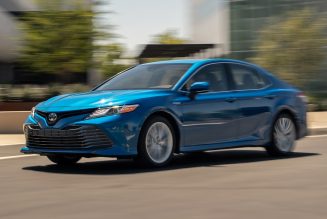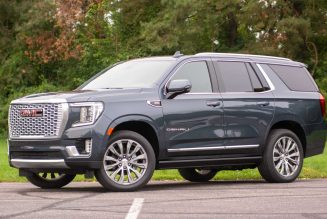“Who is this car for?” That’s what my buddy Mike asked as he looked around the 2021 Lexus LS500. Mike was in from out of town, tasked with housesitting a hilltop pad in ritzy Bel Air—a locale where luxury automobiles like the LS blend in. He likes cars, so I brought the big Lexus over for him to check out. It impressed Mike, but left him confused. Later, I drove home along sweeping Sunset Boulevard. As soothed as I was by the seat massager, that question still bounced around my head. Who is this car for?
We had similar uncertainty when the fifth-generation LS arrived for the 2018 model year. It fit the mold of a luxury full-size sedan, but its stiff ride, harsh powertrain, and snug back seats were atypical of that category. Simultaneously, its sport-sedan-like agility made us wonder if the LS was suffering from an identity crisis. What’s more, the touchpad infotainment interface was endlessly frustrating.
For 2021, Lexus gives the LS a refresh aimed at making it a more compelling flagship. In a rare opportunity, Lexus provided us with pre- and post-refresh models so we could compare the changes back to back. After a week in each and a trip to the track, I’m still not sure if I can answer Mike’s question. But this much is clear: The updated LS500 feels different.
What’s New With the 2021 LS500
First, a recap of the relevant 2021 updates. Not much changes outside. The signature spindle grille, now coated in a darker finish, still dominates the front end. It’s flanked by vents with a more rectangular shape, and headlights that now integrate the LED accent strip. Around back, the taillights swap chrome detailing for black trim. Inside, the seats and armrests gain thicker, plusher foam cushioning, but more noteworthy is the addition of a 12.3-inch infotainment touchscreen—more on that later.
Under the sheetmetal, the spring and damper rates are retuned, different anti-roll bars are installed, and the liquid-filled bushings become larger. Both of our review cars rode on the optional air suspension, which raises and lowers more quickly in the 2021 model. As before, the twin-turbo 3.4-liter V-6 produces 416 hp and 442 lb-ft of torque, but the 10-speed automatic behind it gains new shift logic. Subtle as these changes may seem, they revealed themselves quite clearly.
How Quick Is the LS500?
Some may scoff knowing that the LS500 is equipped with a mere six-cylinder engine, but it delivers. Our rear-wheel-drive 2021 car’s zero-to-60-mph time fell to 5.0 seconds from the 5.3-second time we previously measured from a comparable model. Likewise, this LS did the quarter mile in 13.4 seconds at 106.0 mph, a blink ahead of the earlier 13.8-second, 102.8-mph sprint. (Side note: Acceleration was nearly identical in an all-wheel-drive LS500 we tested.) As engine output is unchanged, it’s possible that the gearbox revisions helped shave those tenths. Nevertheless, associate road test editor Erick Ayapana praised the powerplant, deeming it a “strong engine that launches hard.”
Indeed, on the road it gets the LS500 moving swiftly. Just off idle it doesn’t quite have the effortlessness of a V-8, but by 1,600 rpm full torque has arrived. Keep the pedal buried and the transmission’s new programming makes good use of the gearbox’s tightly spaced cogs. Where the 2020 LS hesitated to downshift, the 2021 readily drops gears and accentuates the engine’s power. Still, shifts aren’t invisible; the first-to-second upshift in particular can jerk slightly, especially when the drivetrain is cold.
Against the lively engine, the brakes feel tuned unapologetically for comfort. This being a luxury sedan that’s not necessarily an issue, but as before, the brake-by-wire system responds inconsistently. There isn’t great correlation between pedal pressure and actual stopping force. Nevertheless, stops are smooth. “Very smooth,” according to Ayapana (emphasis his). Its best 60-to-zero-mph braking result measured 118 feet, longer than the 110-foot stop we got in earlier testing. With no major changes made to the brakes in the refresh, the 2021 car’s different Bridgestone Turanza tires—now mud-and-snow-badged, and with a V speed rating instead of the faster Y—could be to blame for the discrepancy.
Chauffeur’s Delight
We’re not ones to complain when a car handles well. But the pre-refresh LS500’s reflexes and ride quality seemed incongruent with its luxurious mission. Although smooth, it rode with a pervasive coarseness, able to minimize but not erase road chatter. It struggled with larger imperfections, slamming loudly over drainage troughs and potholes. Odd, since it crossed speed bumps as if they were half as tall. For as accurate as its steering felt, it produced quite a bit of body roll. As I was constantly aware of the car’s length, rounding tight corners became a calculated exercise.
Not so in the 2021 model—this thing can boogie. Its slightly quicker turn-in and stronger resistance to lean yield improvements in confidence and control. The result? I can’t say it better than road test editor Chris Walton after his run on the figure-eight course: “Ha! I wasn’t expecting this to be so fun. Steering weight and precision is just right. I can dance it on the edge of over- and understeer and do a glorious controlled slide on corner exit. Whee!” Its result of 26.2 seconds at a 0.68-g average is close to the 26.3-second, 0.71-g average figure-eight lap we recorded from the pre-refresh LS500. Look, numbers don’t tell the whole story—from behind the wheel, the updated LS500 feels like a very different car. Expect the F Sport model to hone that edge further. One doesn’t typically think of the LS as a sport sedan, but now, if you drive it like one, you’ll be pleasantly surprised.
What numbers also can’t communicate is that, despite the tighter handling, comfort is enhanced as well. The ride is calmer, and the cabin feels more insulated from impacts large or small. Fat cats in the back seat will enjoy near-zero gut jiggle and head toss. For the driver and passengers, the LS’s updated chassis is better all around.
Unusual, Awesome Interior
It feels like a smaller car, but the 2021 LS is the same size as before—which is to say, it could be a little bigger. Head- and legroom remain inexplicably tight for a car of this size, particularly in back. Heated, ventilated, reclining, and massaging rear seats aren’t as relaxing without space to sprawl. It’s better up front, as those thrones offer the same amenities and more adjustments. That new thicker cushioning is the first thing I noticed when I got inside. One plutocratic nitpick: The massage function switches off after 15 minutes. Lexus, my massage should end when I want it to, thank you very much.
Regardless of space or lack thereof, the interior décor is stunning. The layered trim and dramatic sculpting makes competitors’ cabins seem plain. How our test car’s gorgeous “Art Wood” veneer is produced is worth watching. Functional necessities are artfully crafted—check out the air vents integrated within the lines flowing across the dashboard, or the katana-shaped door handles. The upholstery below the gear selector might be the industry’s tiniest piece of leather. Wonderful details like these help the interior feel truly special.
High-Tech and Behind the Times
Less artful is the new infotainment setup, which at last adopts touchscreen functionality. At 12.3 inches, the display is no larger, but the experience is much improved compared to the previous touchpad-controlled system. No longer is it necessary to swipe endlessly to make a selection—just touch and go. However, its enclosure looks a bit tacked on, an adaptation needed to put it within reach. The trouble is the screen is so large its right side still requires a stretch to access. The touchpad remains, so at least there’s redundancy to work with. Apple CarPlay and Android Auto are now standard.
Some of the LS’s tech reminds how far things have come in a few short years. The digital gauge display looks small compared to what’s found in some new economy cars, and offers less functionality. An available head-up display behind it provides more information, albeit arranged in a confusing jumble. The driver-assistance suite isn’t as refined as newer systems; its lane-keep assist ping-pongs between the lines. Our test car’s digital rearview mirror helped, but oddly magnified the view behind. And a CD player is standard—need I say more? All this aside, the optional 23-speaker audio system is magnificent, drenching the cabin in layers of rich, immersive sound.
How Much Is a LS500?
Prices for the 2021 LS500 start at $77,025, and the grand total for our option-rich refreshed test vehicle came to $101,790. A palatial sum—but against the competition, a potential bargain. The Audi A8 starts at $87,545, and the BMW 7 Series at $87,795. The new Mercedes-Benz S-Class commands—ready for this?—a whopping $110,850. With the Kia K900 now dead, only the $73,975 Genesis G90 is cheaper in the segment. Note that, besides the Benz, all of these vehicles are standard equipped with smaller, less-powerful six-cylinder engines than the LS500’s. If you’re willing to pay, though, they all do offer far more powerful engines, which the LS does not.
So, Who Is This Car For?
Sorry, Mike—I don’t have an answer for your question. Those who want a car to be driven in should try on something with more spacious rear seats. Others who seek a more involved driving experience have better options in the luxury midsize sedan category. The LS500 remains a quirky outlier stuck between those strata. But what I can tell you is this: Its 2021 refresh is a success. I came to liken the LS to a four-door gran turismo, a whimsical machine that’s a pleasure breezing down a motorway or winding through a scenic bypass. It’s not everything for everyone, but for a certain someone, it’s superb.
| 2021 Lexus LS500 | |
| BASE PRICE | $77,025 |
| PRICE AS TESTED | $101,790 |
| VEHICLE LAYOUT | Front-engine, RWD, 5-pass, 4-door sedan |
| ENGINE | 3.4L/416-hp/442-lb-ft twin-turbo DOHC 24-valve V-6 |
| TRANSMISSION | 10-speed automatic |
| CURB WEIGHT (F/R DIST) | 4,925 lb (52/48%) |
| WHEELBASE | 123.0 in |
| LENGTH x WIDTH x HEIGHT | 206.1 x 74.8 x 57.1 in |
| 0-60 MPH | 5.0 sec |
| QUARTER MILE | 13.4 sec @ 106.0 mph |
| BRAKING, 60-0 MPH | 118 ft |
| LATERAL ACCELERATION | 0.83 g (avg) |
| MT FIGURE EIGHT | 26.2 sec @ 0.68 g (avg) |
| EPA CITY/HWY/COMB FUEL ECON | 18/29/22 mpg |
| ENERGY CONS, CITY/HWY | 187/116 kWh/100 miles |
| CO2 EMISSIONS, COMB | 0.89 lb/mile |







